Dos Senderos 100k
Your race lineup might be getting out of hand when you think of a race as “only a 100k”.
After running (and winning!) the Rocky Raccoon 100-miler, it became hard to take anything else seriously. My next race, the Dos Senderos 100k, was less than two-thirds the distance, and had less than half as much climbing as the Bandera 100k. On top of that, this was the inaugural year of the race, so the field probably wouldn’t be that competitive.
For those reasons, and perhaps due to burnout, I took too many rest days after Rocky Raccoon and ate myself out-of-shape. Only 2.5 weeks before race day, I finally snapped out of it and began training and eating (mostly) properly again. On race day, I still weighed 3 kg (6.6 lbs) more than I had a month prior at Rocky Raccoon. On a guy my size, that’s a lot.
The race was held in Pedernales State Park and Flat Creek Crossing Ranch, and the course consisted of one loop in each park (hence the name “Dos Senderos”). Being less than 45 minutes away from Wimberley, this meant I got to sleep in my own bed the night before. But since the race inexplicably started at 6:00 AM - over an hour before sunrise - this also meant I had to wake up early.
When I arrived, it was still pitch black, and there was hardly anyone there. It was quiet. It almost felt like I’d arrived too early, or at the wrong place, but nope, this was it. Only the 100k started at 6:00 AM; every other distance started at 7:00 AM or later. And there were only 17 people running the 100k.
I found the check-in tent and a volunteer handed me my bib and chip.
“You’re number seven, wear this chip around your ankle…”
I looked at the bib. It had two leading zeros.
“I’m not number seven.”
The volunteer stopped and looked at me funny.
“I’m Double-O Seven!!”
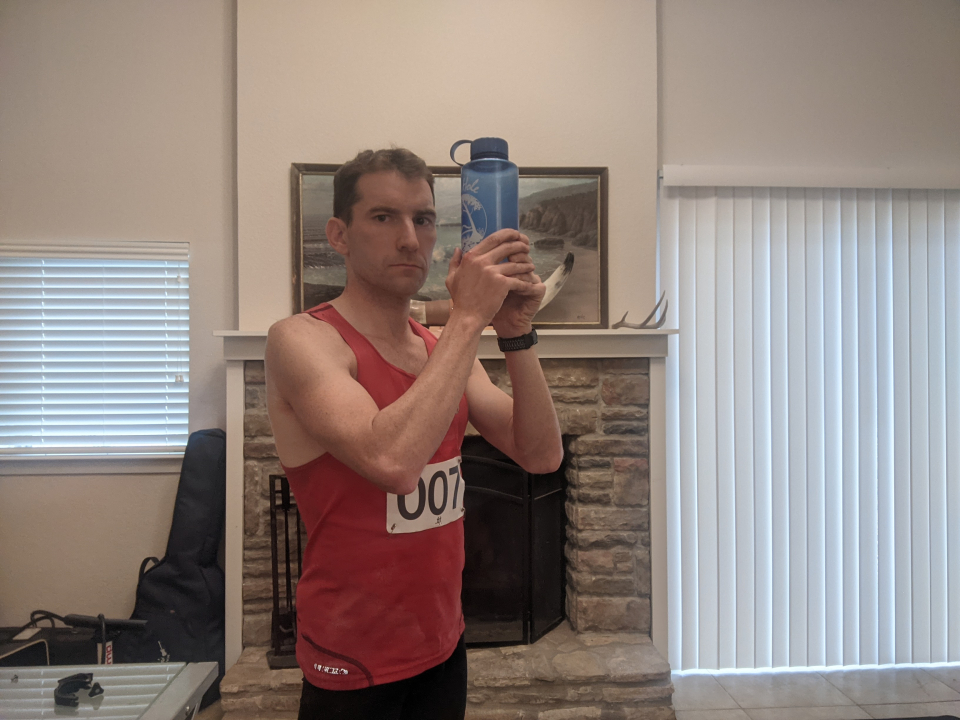
By far the coolest bib number I’ve ever had.
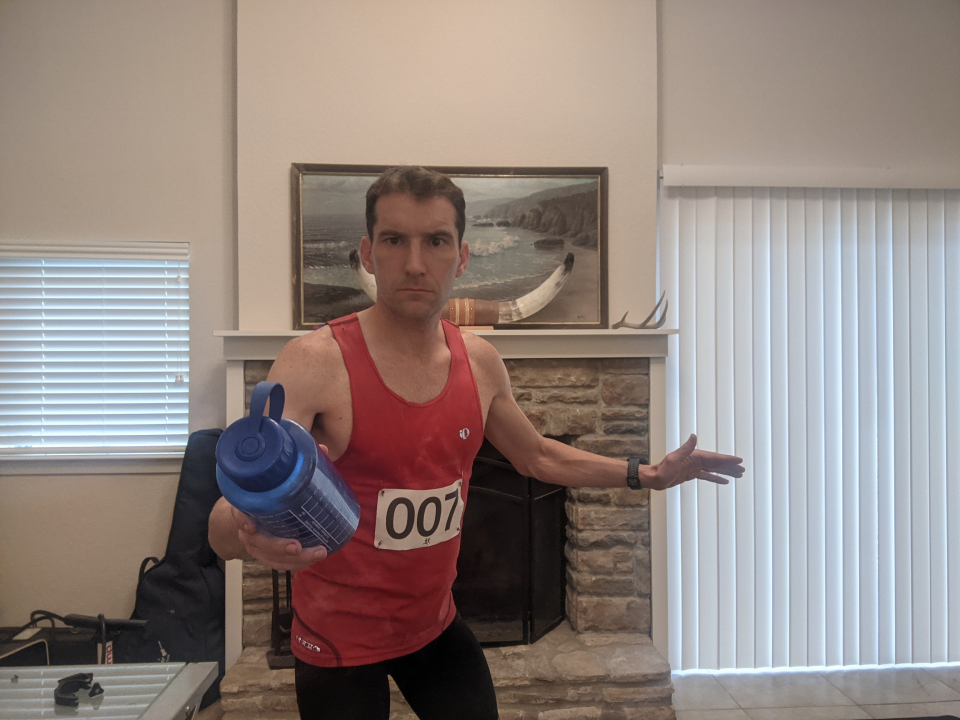
With such a small group, there was somewhat of a lack of excitement in the minutes before the race. People didn’t even toe the start line; most everyone kinda hung around somewhere in the general starting area until the race director said “Go.” A flurry of bobbing headlamps and we’re off. I got out in front. No one followed me.
I spent the entire race alone.
As I’d suspected, if there was one race on my spring docket for which it was OK to be slightly out-of-shape, this was it. Sure, there were other good runners, but no elites or sub-elites. On top of that, the course wasn’t particularly difficult; mile-for-mile, it had less climbing than my standard training loop in Wimberley.
That said, it wasn’t easy either. The first leg, which lasted 10 km, was mostly in the dark, on a “trail” that could better be described as a long pile of rocks. While technical, it was mostly flat, but rock-hopping can’t be done quickly in the dark, when you can only see a few meters in front of you. At one point, I wound up losing some skin on a knuckle when I misjudged how close a tree was and essentially punched it as I ran past.
After 45 minutes, the skies had lightened up enough to turn off the waist light, and less than ten minutes later, I arrived at the first aid station. The drop bags weren’t to be delivered until after all distances started at 7:00 AM, so I left my light hanging from a corner of the canopy tent. I’d drop it in my bag when I revisited this station later.
The first aid station came at the end of a 1.5 km out-and-back. By the time I finished doubling back and split off, I still hadn’t seen anyone.
11 km and I’m already more than 1.5 km ahead of 2nd place. This could turn into a butt-whoopin’.
The out-and-back section was a brief reprieve from the rocky trail, but the majority of the 2nd leg was much like the 1st - flat and technical. It felt a lot easier though, since you could see farther ahead and plan your steps better. What little research I was able to do indicated that the trail conditions after the 2nd aid station would be much easier, so it came as a relief to get that first 21 km done.
The wind was considerably strong all day, even early in the morning, and the 3rd and 4th legs were the only time you were in an area deforested enough to notice. Fortunately, the wind was in your favor for most of this section! The trail was a lot more run-able as well. My average pace kept dropping.
I finally ate something at the 3rd aid station, and nearly as soon as I pulled the power oatmeal out of my drop bag, one of the volunteers asked what was in it. Between mouthfuls, I did my best to describe it.
“Oatmeal, quinoa, almond butter, chia seeds, sport drink powder. Powdered beet is what makes it purple.” *gulp* “It’s kinda like a homemade Clif bar in a bowl, that you don’t have to chew.”
My purple sludge always seems to attract attention. But hey, it works!
After 34 km, I reached the aid station at the start/finish area. At this point, it was a 16 km (10 mi) loop in Flat Creek Crossing before returning back here, then doing it all over again. I knew I was in the lead, but wanted to know by how much, so I asked a volunteer,
“Hey, could you do me a favor?”
“Sure! Watchu need?”
“When I get back here, could you tell me how much time passed before the 2nd place guy got to where I am now?”
There was a moment of confusion, but he eventually understood what I was asking.
“Great! Now which way do I go? Back that way?”
“Oh! Uhhhhhhh, I dunno…hang on.”
There were about half a dozen volunteers around, and none of them knew which way to go from this aid station. I had to wait a minute while someone walked over to the race director and asked. He walked back over.
“So you just ran 22 miles?”
Let’s see, I’ve done 34 km, that’s ~22 miles, “Yeah!”
“You got 10 to go before you get back here. You go that way.” He pointed.
“Great! Thanks!”
That seems like the most important thing to make sure the volunteers know.
The 16 km in Flat Creek Crossing was about as technical as the first 20 km of the Pedernales loop, and in places, it was hard to even tell which way the trail went. At other times, the “trail” deteriorated to the point that you had no choice but to walk a short distance.
For the first time, I was sharing the trail with other runners, who had started some other distance later than I had and were finishing up. Most of them were hiking.
Precisely halfway through the loop, in a wide-open grassy area, was the last aid station. They were playing good music. I had no drop bag here and simply ate some fruit. More of the same technical trail in the last 8 km, some of which was not a trail, but a dry creek bed. Other parts were a mountain bike pump track, complete with ramps and jumps. Most of them were merely in the dammit category, but a few were in you gotta be friggin’ kidding me territory.
At long last, I reached the start/finish area again. The sun had come out. It was warm (20+ °C, or 70+ °F). Halfway there. Time to do it all over again.
The volunteer I’d talked to last time spotted me.
“40 minutes back!”
“40?”
“40 minutes! You’re way ahead! Killin’ it, man!”
I took another gulp of water and smiled.
“Hey, sorry about that mix-up with directions last time, you were the first one through, and-”
“It happens.” After receiving that good news, I didn’t care anymore.
I finished up and started the second loop. I still felt good, and as far as I could tell, hadn’t slowed down yet.
I might finish this section faster than I did last time, now that I can see. Seriously, who starts a race before the sun comes up?!?
When I arrived at the Wolfhead aid station, which gets visited twice on each loop, I asked the volunteers the same favor: Tell me how far back 2nd place is.
After finishing the first half in 4:15, I had the reasonable expectation of finishing in under nine hours…until the leg between Wolfhead and Gate aid stations. Somehow, I didn’t remember it being this rocky last time. The second time around, it seemed even worse than the first section. Maybe last time, the addition of daylight made it feel easier in comparison. Maybe this time, the heat of the afternoon was starting to bother me. Maybe I was simply getting tired. My pace sagged. If I kept this up, the nine hour mark was going to slip away.
I intentionally took in a little extra water at the Gate aid station before leaving, factoring in the warm air. The breezy conditions helped, especially in terms of staying dry instead of drenched in sweat. Knowing the next 14 km were much easier, and the aid stations would be much closer together, lifted my spirits. Almost immediately after leaving Gate, my pace skyrocketed. Trail conditions make a huge difference.
Now that I could properly run again, I was giving myself more and more buffer to play with and still finish in under nine hours. With every klick that passed, I did the math in my head to see what pace I’d need to hold in order to finish in exactly 9:00:00. The number slowly crept from the low 5s to the upper 5s. I was pleased.
As soon as I arrived at Wolfhead, a volunteer called out, “Hour and a half!”
“90 minutes exactly?”
“Well, at least that.”
“We haven’t seen anyone,” two other guys said in unison.
22 km to go and I’m over 90 minutes ahead! Holy crap!
“You could probably walk it in and still win!”
He was right; I could. But nine hours was still a possibility, and I wanted it.
“I’m trying to finish in nine hours, and I’m at a good pace, so that’s still on the table. Only thing is it’s getting warm, and those last ten miles suuuuuuuck!!!”
They were still infatuated by my power oatmeal. Maybe I need to sell that stuff.
The section between Wolfhead and the start/finish is the easiest part of the course from a technical standpoint, but also contains the most hills. On the first loop, that hadn’t bothered me in the least, but this time around, it did. My pace was still good, but I wasn’t getting as far ahead as I’d hoped. I knew I’d slow down in the Flat Creek Crossing section. The only question was how much.
There were a lot of people hanging around in the start/finish area when I arrived at the aid station with 16 km (10 mi) to go. Presumably 50k finishers. A lot of them were drinking beer and there seemed to be a party atmosphere going on. I smiled. I’d be joining in soon.
My pace predictably slowed in Flat Creek Crossing, but thankfully, I’d given myself enough buffer that it didn’t matter much. With 16 km to go, I could maintain a 6:00/km pace (quite slow for me) and still finish in under 9:00:00, and that number eventually reached 6:30/km, then 7:00, 8:00, until it was over 10:00/km.
Alright, now you got this…
I walked a few of the you gotta be friggin’ kidding hills this time, knowing all my goals were in the bag, then crossed the finish line smiling in 8:56:58. Beat nine hours by mere minutes, but I beat it.
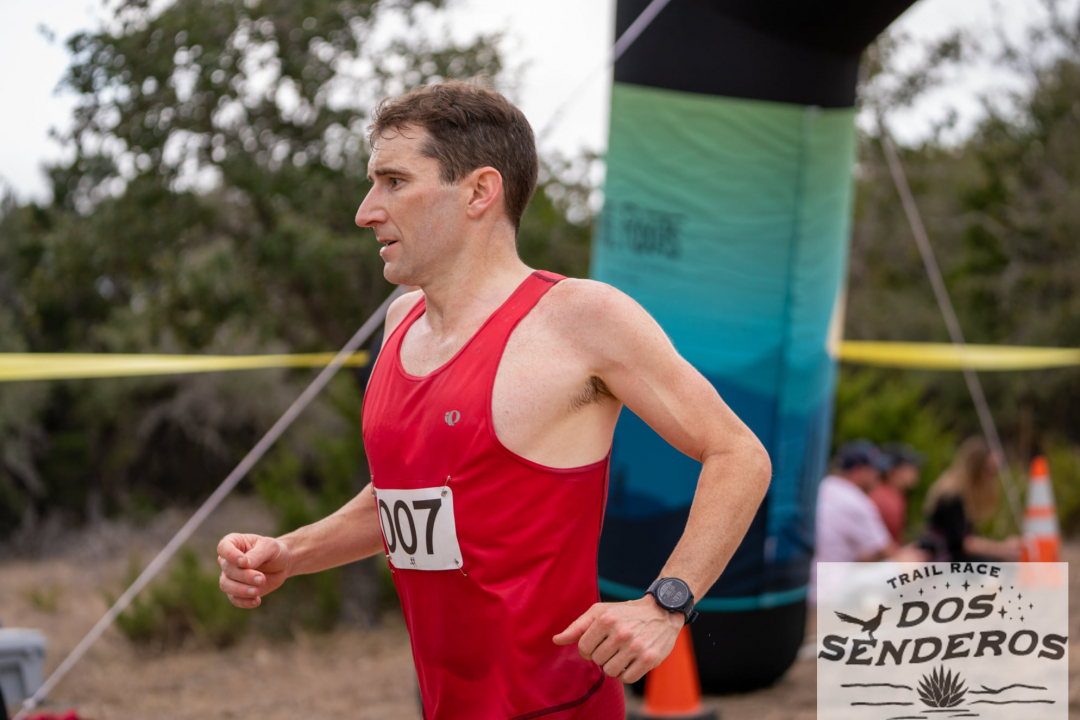
In the end, the course reminded me a lot of the Bandera 100k, with less hills, but equally technical and otherwise similar terrain. Overall, I enjoyed it. I might do it again.
After a small amount of recuperation, I drove to the aid stations to pick up my drop bags before I sat down with a free beer and finally enjoyed the victory. Several of the volunteers were representatives from REI, one of which helped me clean my bloody knuckle. I asked them about getting sponsored, and they replied that it was quite rare. I should try anyway.
I didn’t leave for home until three hours after I’d finished. I still didn’t see the 2nd place guy come through. I think the scientific name for that is a butt-whoopin’.
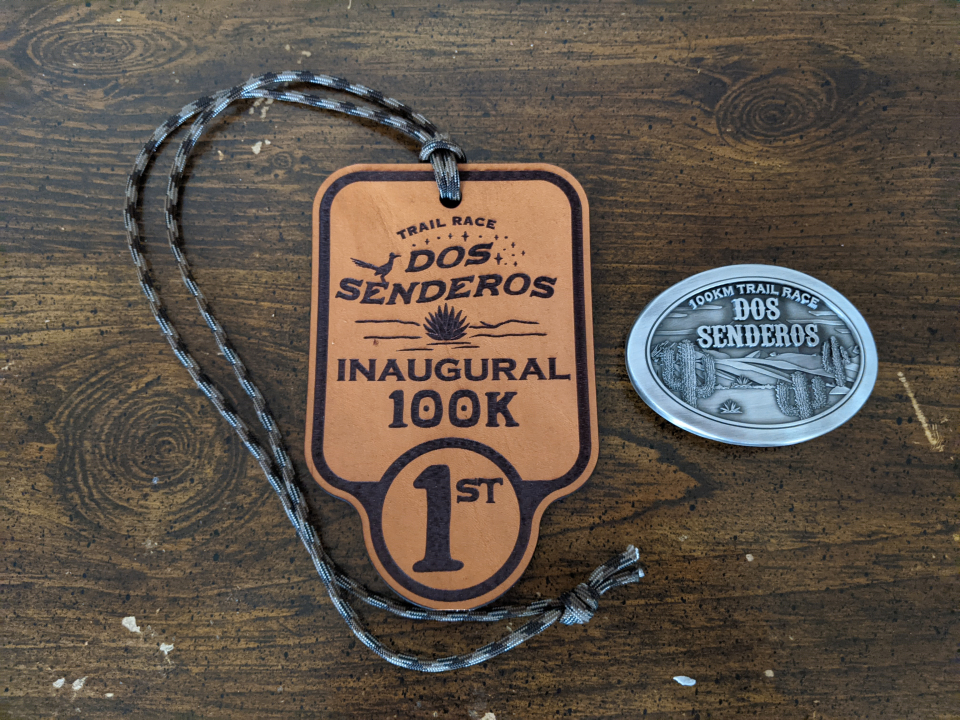
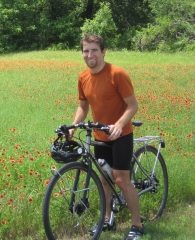


 June
June

